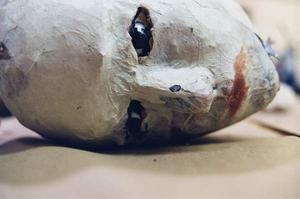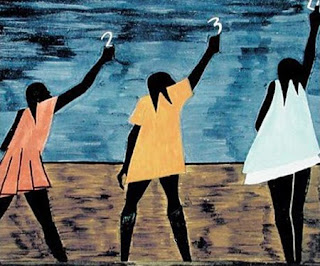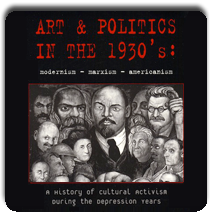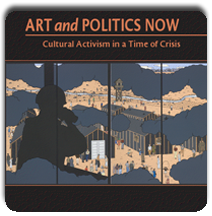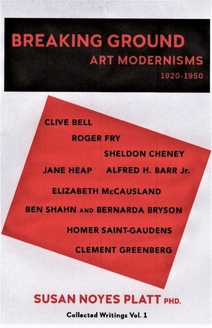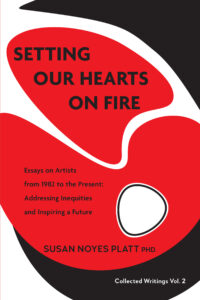Kiki Smith 2 and Milton Rogovin
So I went back to the Henry Art Gallery’s Kiki Smith exhibition “I myself have seen it” for another look. It is a complex exhibition and deserves a lot of looks. First I watched the Art 21 video which was really helpful . She talks about death masks, her grandmother’s, her father’s, her sister’s. She herself is cast, that is terrifying. And she talked about Genevieve the savior of Paris.
So when I saw the series about Genevieve in the exhibition, it was clear what she was doing. The exhibition includes six photographs of parts of the sculpture, a profile face, lips, a hand, the legs of a wolf ( perhaps signifying the enemy that Genevieve’s prayers staved off from Paris), the wolf’s furry face, four animal feet. Together they create an imaginary narrative, much more than the sculpture in which G calmly steps over a supine animal, but this narrative is another story, a story of fragments of bodies that seem to be frozen, even as they create, collectively, a sense of anxiety. The stasis is perhaps related to Genevieve’s spiritual nature. But there didn’t seem to be any suggestion of the actions that she took to save the people by bringing grain.
Going through the rest of the show starting with a young girl trapped (floating?) in a branch, to odd photographs that seem to evoke fragments of organs, to Mary Magdalene ( we know her story, Christ’s “fallen” woman) , to Lot’s Wife (who turned to a pillar of salt, if you remember), to the Harpies (perched about on mouldings high above us) , to the witches, to the little girls, dead white animals, dead black crows, shredded puppet, worms, and a photograph of just Guanyin’s head on its side (the image is in previous post) which does not suggest her power as a goddess of love and mercy and childbearing. There is only one message for me – violence against women, and especially little girls. The show is presenting frighened girls and oddly powerless witches. Even fairy tales where little girls succeed, like Alice in Wonderland, seem to be oddly ambibuous – will she succeed in escaping her pursuers??
The question is why doesn’t Kiki Smith say what her real subject is, why is she so unwilling to be an advocate for all the victims she creates in her sculptures?? Why does she make victims from powerful goddesses and biblical women. Why can’t they fight back? Why doesn’t she fight back? My intelligent friend Deborah Lawrence talked me out of saying it is about personal trauma. What do I know, but why is Smith so obsessed with this single subject of death and threats of death and powerlessness.
The contrast to Cindy Sherman comes to mind who works from film, that, like fairy tales, are often about violence against women (in fact the new mythology), but we know they are re-staged with herself as the main actor, and she is opposing violence against women by calling attention to it.
Kiki adds to the victims in the world without doing anything for them. As far as I am concerned this is not feminism.
In an intriguing revelation, she mentioned that she had worked with Bread and Puppet theater for awhile. But she takes their confrontational approach and empties it of all resistance in making these prone or frozen or fragmented women and girls.
And what an amazing contrast to the adjacent gallery at the Henry with the photography of Milton Rogovin.
He has photographed the working class for fifty years. He went to Chile ( the image above is from Chile,) Appalachia, photographing. among others, the families of miners and the miners themselves (particularly resonant at the moment with the horrifying greed propelled, mine accidents in the non unionized mines )and repeatedly to the Lower West Side of New York City. His people are dignfiedand strong. He honors them with his photographs.
He wrote poetry about the subjects of his work.
Here are a few of his comments.
“They are regular people just like the rest of us. We must not abandon them.”
“Everybody should have an opportunity for a better education.”
” All around we saw people with great potential but we knew none of them would realize it under the conditions of our society.”
Here is a man who cares deeply about the human condition and has spent his life recording it and speaking up for what he believes.
This entry was posted on April 10, 2010 and is filed under "I myself have seen it", Henry Art Gallery, Kiki Smith 2, Milton Rogovin, violence against women.
Kiki Smith
The Kiki Smith exhibition at the Henry Art Gallery, curated by Elizabeth Brown, in collaboration with the artist for many years and years, is a tour de force, not to be missed. Together they went through about 80,000 photographs to arrive at the show. Hats off for a great show and a great installation.
Brown wrote her dissertation on Brancusi’s photographs of his own work, those haunting black and white photographs that were first published in the Little Review in the early 1920s by the eccentric genius Jane Heap. (See my website for more information on her). But what a difference. Compared to Brancusi’s actions which were relatively straightforward, although the results were beautiful, Kiki Smith, is like walking into a complex game in which we have no idea which way to go or what the rules are.
The title ” I myself have seen it: Photography and Kiki Smith ” refers to the fact that these are Kiki’s photographs of many different types, documentary, journalistic, casual, creative, serendipitous.
Those of us in the press conversed with the artist informally -a great opportunity to try to get a little more straightforward information from the artist ( her artists talk was aggravatingly indirect, and my bete noir, about her materials and where she got them, although she had some good one liners).
Naturally, I asked her if she was concerned about environmental issues, since we were standing in a room with a lot of simulations of dead white mammals, and also a crucified Christ photograph ( that’s my nod to Good Friday, today). She said she didn’t like to be polemical, she didn’t like to tell people what to think. Where have we heard that before? But in her case, it is true. She lays out the work, the death, the damage, the anguished adolescent girls, the mythic women, the fairy tale girls, the composite bird women, but they are all strangely passive. Oddly, she said the same thing as William Kentridge, that making art flows from her subconscious, she doesn’t know what she is going to do ahead of time. But with wildly different results. Kiki Smith does not engage social political issues, we must conclude that spontaneity is conditioned by who we are. In Kiki Smith’s case, I think this show gives us a whole new perspective on who she is and what her work is about.
When I asked her about AIDS, since that was the first work I saw that impressed me at the height of the epidemic (in the art world), she said, oh I just happened to be doing work about the body then (she also said when she took emergency medical training it was just to clinically analyze the bodies) .But her sister had jsut died of AIDS! So where is the anguish, the emotion, the passion? Anyone that can produce this much work has passion, but there is a strangely absent quality, a sense that somehow her consciousness is somewhere else.
Now I am going to make a big leap and a big guess. When I saw the movie Precious, one of the key devices was that when she was being raped, she would escape into fantasy, wonderful living color celebrity status fantasy. She was absent from the world in those times.
I see the same absence in Kiki Smith, her women lie wounded, or stand introverted, her crows are dead, her imagery of Little Red Riding Hood morphing into a wolf/girl doesn’t suggest she is empowered by this transformation. Lilith, another woman who has had a raw deal, is just Lilith, not all conquiering Lilith. So what about Kiki’s absent emotions. Is this a result of early traumas? I am not going to go further with this and get more explicit, but that was the message of the show for me. Going from Kiki Smith to William Kentridge, from the “feminist” introvert standing or lying passively, to the male activist declaring greed and capitalism wrong was quite a contrast. I still haven’t digested it. I respect Kiki Smith for what she has done, but I wish she would stand up and declare herself. We have to penetrate the obfuscating indirectness ( which is strangely, deeply allied with sixties modernism, as became clear in the lecture).
But the show is really wonderful, dozens of images, all of them beautiful in themselves, that together give us a whole new perspective on Kiki Smith. The Seattle Weekly had a nice analysis of the experience of looking at the show, up, down, and eye level. Sharon Arnold did a wonderful analysis from a completely different perspective than mine.
This entry was posted on April 3, 2010 and is filed under "I myself have seen it", Henry Art Gallery, Kiki Smith.
Plum Blossoms in the Spring Pure Poetry
This is my springtime celebration.
I stood under our plum tree and photographed it.
I felt the sheer beauty of the tree, its blossoms, its unpredictable branches
and
I understood why
gnenerations of artists in Japan and China have painted this subject.
In the midst of our war filled planet, and my militarized country,
I was grateful that I could pause for a moment
to immerse myself in this tree.
This entry was posted on March 26, 2010 and is filed under Plum Blossoms for a moment.
The William Kentridge Moment in New York CIty
 I was privileged to be there, during what was referred to as the “William Kentridge moment” in New York City. It combined his major exhibition at the Museum of Modern Art, “Five Themes”, a lecture at the New York Public Library “Learning from the Absurd” and his groundbreaking production of “The Nose” at the Metropolitan Opera. William Kentridge directed, made the set designs (with Sabine Theunissen), and staging, (including a nose the size of a human being dancing around and even singing ), proscenium curtain, and banner. Also part of his team was Urs Schonebaum from Munich, who did the lighting, and Catherine Meyburgh from South Africa who did the video compostions.
I was privileged to be there, during what was referred to as the “William Kentridge moment” in New York City. It combined his major exhibition at the Museum of Modern Art, “Five Themes”, a lecture at the New York Public Library “Learning from the Absurd” and his groundbreaking production of “The Nose” at the Metropolitan Opera. William Kentridge directed, made the set designs (with Sabine Theunissen), and staging, (including a nose the size of a human being dancing around and even singing ), proscenium curtain, and banner. Also part of his team was Urs Schonebaum from Munich, who did the lighting, and Catherine Meyburgh from South Africa who did the video compostions.
Dimitri Shostakovich wrote the opera in 1928 at the age of 22. It was produced in 1930 ( in Leningrad/St. Petersburg). It was not performed in the Soviet Union again until 1974. Shostakovich survived Stalinism, unlike many of his brilliant contemporaries, but he was shattered by it. “The Nose” represents a watershed moment of brilliant experimentation.
At the Metropolitan Opera the music was conducted by world famous Shostakovich expert Valery Gergiev. Its extraordinary music is atonal and non lyrical, as well as filled with satirical references to traditional musical forms like folk music and chorales. But its main characteristic is the incredible use of unpitched percussion. It is based on a Gogol short story of ten pages called The Nose, written in 1836. The nose is a character on its own. The owner of the nose wakes up to discover his nose is gone, he has various adventures ( as the nose dances around the stage in both real time and on the animated film sequences that Kentridge created, borrowing from all sorts of Russian, modernist sources.) The extraordinary singing by Paulo Szot, who played Kovalyov, the mid level bureaucrat who lost his nose when he had a shave ( it fell into the barber’s flour supply and reappeared in his bread the next morning) and therefore his position in the world, is a Brazilian baritone who sang almost non stop for one and a half hours. He was thrilling. I am now a convert to opera.
Kentridge animated the stage and its surroundings with the Russian avant garde art of Lissitzky, Malevich, with moving red squares, black lines, red circles. The costumes ( by Greta Goiris) drew on Popova’s famed constructivist inspired dresses. The proscenium curtain was a giant collage with all sorts of amusing references, such as a list of the hierarchies of people under the tsar that starts with angels, the tsar, with actors way down the list with slaves, then thieves, pirates, gypsies, Jews/Muslims, animals, plants and finally stones. Then there was the hierarchy in Stalinist Russia, self seekers, loafers, careerists, morally corrupt, cadets menshiviks, democratic centralists, workers opposition, three times contemptible degenerates. Then there is the hierarchy ( not on the curtain, but recited in the lecture) of apartheid South Africa, Whites, Japanese, Chinese, Other Asians, Indian, colored, black. And we know about Mexico and its mind bogglingly complex castata. Which is to say that all hierarchies are futile exercises in arbitrary and meaningless status driven by the desire for power. The Nose, short story, opera, performance all refer to the absurdity of stature and how it is endowed.
Kentridge has also done a performance that related directly to the Opera, “I am not me, The Horse is Not Mine,” which I wrote about when I saw it last year ( search the blog under Kentridge). His theme is the great aspirations and tragic failure of the Russian Revolution and its artists. And yet, the exuberance of his set and the staging of the absurdist play suggests his love of this art as well as its hopes. The performance began with an animation of the silhouette of a marching worker carrying a red flag across the stage. ( We all know about the importance of processions for Kentridge with the layers of meaning from protest to desperation)
Kentridge as a white South African and genre defying artist, working in animated film, drawing, prints, and collage, is deeply political, but he defined it, in a conversation at the New York Public Library, as conveying the political as surprising, as having an “uncertain ending.” His work is laced with the humor of the Cabaret Voltaire defiance of World War I and its absurd performances. He throws us off from any certainty, he plays with the ridiculous, the illogical, the embarrassing , the accidental, the digressive, selecting from various experimental actions what will work in his performances. He has given us “sketches” in a DVD accompanying his book Five Themes that include some of the ideas he didn’t use. He is absolutely in tune with Gogol and Shostakovich themselves, who perpetuated the same kind of disruptions with the novel and music respectively.
His animated films, including the story of Soho Ekstein, the greedy capitalist, and Felix Teitelbaum the neurotic lover, along with Mrs. Eckstein are about greed and love (love as a type of greed). His technique of animating drawings by sequential erasers is poignent and deeply moving. Ubu and the Truth Commission, with Ubu referring back to another Dada character, the impossibly self important despot Ubu from the Alfred Jarry play, is another performance that uses puppets, as he did last year in “The Return of Ulysses.” “Ubu Tells the Truth” a film from 1997 has some shockingly violent sequences, including a person being chopped up and exploded three times.
From the Soho and Felix group, here is a line of starving workers and nearby the greedy capitalist stuffs his face from Kentridge’s first film, Johannesburg, the Second Greatest City after Paris, 1989. One vivid image in this film was the capitalist using a coffee press, and the press goes right down into the deep underground and sets off charges that explode into the veins of a mine. 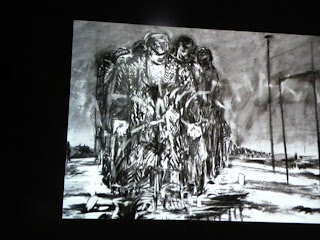
The Nose opera, the exhibition at the Museum of Modern Art, the lecture, all together comprise the astonishing work of one of the most extraordinary artists working today. He draws on not only Russian avant-garde art of the 1920s and Dada, but also on German Expressionism, that great style of political protest art in Germany.
Living in post apartheid South Africa and having lived tin South Africa all his life, he is acutely aware of the absurdity of contrived hierarchies that make some people superior to other people. He is undermining those certainties of who is important and who is not, and Gogol’s short story and Shostakovich’s opera with their wandering nose looking for status, removing it from its owner, and giving it to another person of “higher rank”, etc, is a perfect ( he would say literal) example of the absurdity of who is powerful and who is not. That is the most subversive political statement I can imagine.
Of course, I am myself very opinionated about politics, and I feel that opinions and taking a stand for what I believe in is important. So why does Kentridge appeal to me so much? Because I can feel that underlying the wonderful humor, the absurdities, there is a man who cares very, very deeply about humanity. His work “the Black Box,” addressing the ravaging of Africa by whites in the nineteenth century, is filled with pathos. The arbitrary slaughter of rhinocerous shown with vintage footage, connects directly to our continuing random slaughter of the planet for sport and greed.
But Kentridge also believes that humor, of which he makes such use in many of his works, can encompass the experience of the many, while tragedy only the experience of the individual. So he relies on humor, our collective laughter, and our recognition of our shared humanity as we laugh, to get ideas across.
In The Nose performance, and the related section of MOMA exhibition, Bukharin, that most deeply intellectual of the early Russian Revolutionary idealists, speaks up for humanity, may also speak for Kentridge, even as the words are those of a man who is laughed at, and, ultimately, condemned.
There is a lot more to say, but I will stop there for now. Kentridge will be the Conclusion of my book on Art and Politics Now so buy the book next summer when it comes out for more analysis.

Kentridge at the New York Public Library.
PS And the contrast could not have been starker with the shallow and failed works in the 2010 Whitney Biennial. I hope those artists attend Kentridge’s exhibition.
This entry was posted on March 20, 2010 and is filed under "the Kentridge moment", South Africa, The Nose, the Whitney Biennial, William Kentridge.
International Women’s Day March in Seattle
On Saturday March 6 we had an amazing march. We walked for over two hours and went to a recruiting station, the King County Jail, the ICE Immigration Center and Seattle Human Services, with a rally/ speaker in front of each place. We ended at Occidental Square where the Duwamish were there in spirit. We had all ages, all ethnicities, all issues, all political positions joining together. Radical Women were well represented. Also Amnesty International, as well as National Organization of Women, and Pinay, Gabriela, CARA, photographs below and more information. It was exhiliarating and inspiring.
 Pinay Filipina group. Gabriela was also represented, a mass solidarity group that is politically leftist and really activist.
Pinay Filipina group. Gabriela was also represented, a mass solidarity group that is politically leftist and really activist.
They led us in chants. This child is left behind after his parents were deported. He is an American citizen so he got to stay here all by himself. He looks like he is about four years old.
This child is left behind after his parents were deported. He is an American citizen so he got to stay here all by himself. He looks like he is about four years old.
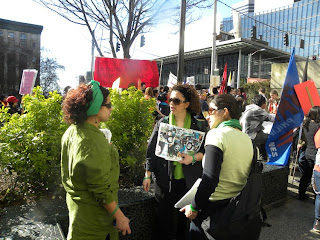 These are Iranian women offering us information for supporting the women of Iran
These are Iranian women offering us information for supporting the women of Iran
 This is Margo Heights speaking in front of the Jail and across the street from ICE ( Immigration Detention Center). 1 our of every 3 women on the planet who are in jail is locked up in the United States.
This is Margo Heights speaking in front of the Jail and across the street from ICE ( Immigration Detention Center). 1 our of every 3 women on the planet who are in jail is locked up in the United States.Most women are imprisoned for economic crivmes. The majority of women convicted for violent crimes were defending themselves or their children against abuse. In the U.S. a woman is raped every six minutes.
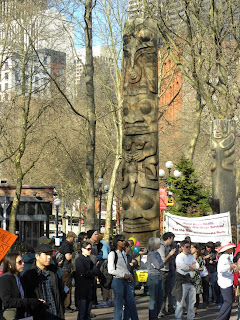 The Duwamish watching over us in this space that used to belong to them, although they didn’t make the totem pole and totem poles are not a Duwamish art form, at least it is a reference to the Indigenous people who lived in Seattle.
The Duwamish watching over us in this space that used to belong to them, although they didn’t make the totem pole and totem poles are not a Duwamish art form, at least it is a reference to the Indigenous people who lived in Seattle. 
No explanation needed

A young feminist ready to play songs for us.
This entry was posted on March 9, 2010 and is filed under CARA, Gabriela, International Womens March Seattle, Iranian Women, Pinay, Radical Women.
Break the Silence Olympia-Rafah Solidarity Mural Project
 These are a few of the leaves on the Olympia Rafah Solidarity Mural Project. It is intended to build solidarity among people globally
These are a few of the leaves on the Olympia Rafah Solidarity Mural Project. It is intended to build solidarity among people globally
Take a look and see below for more information.

 “If you have come to help me than you are wasting your time. But if you have come because your liberation is bound up in mine, let us walk together”
“If you have come to help me than you are wasting your time. But if you have come because your liberation is bound up in mine, let us walk together”
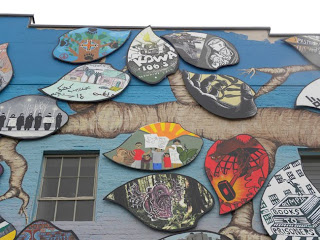
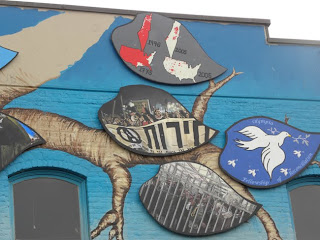 Break the Silence Mural project has been collaborating with communities in Rafah and elsewhere in the Occupied Territories to paint murals for nineteen years. The mural in this post is in Olympia Washington co-sponsored by the Rachel Corrie Foundation, the Middle East Children’s Alliance, the Gaza Community Mental Health Community, Program and the Olympia Salvage Company.
Break the Silence Mural project has been collaborating with communities in Rafah and elsewhere in the Occupied Territories to paint murals for nineteen years. The mural in this post is in Olympia Washington co-sponsored by the Rachel Corrie Foundation, the Middle East Children’s Alliance, the Gaza Community Mental Health Community, Program and the Olympia Salvage Company.
It was inspired by the life of Rachel Corrie as part of her dream of creating a sister city project between Olympia and Rafah, Gaza Strip.
It includes over one hundred and fifty separate large leaves on an olive tree that spans one hundred feet. It was painted by peace and justice groups from all over the world, a remarkable job of collaboration, and logisitical organization. Hundreds of artists of all ages contributed to the mural.
Each leaf will eventually have a recording that tells about the group that made it, or some information about their political concerns. You can see there are a range of different ideas, resistance, peaceful solidarity, women’s rights, and anti racism.
In the image just above you can see a dove flying off to the right. At the top is Gail Tremblay’s leaf, which has maps that compare in red land belonging to Palestinians in 1948 and 2005 and below, land belonging to US Indians in 1775 asnd 2005. It has caused controversy among some Jewish people in Olympia, because it is clearly sympathetic with the plight of the Palestininan people. But Break the Silence is the project of a several Jewish artists who cannot remain silent when the Israelis are acting in their name to kill and oppress the Palestinians. In fact, most of the artists that I know about who are most active in making art about the Palestinians are Jewish. Selma Waldman for example, whom I have mentioned often here, and who would certainly have contributed a leaf if she were still alive.
This entry was posted on and is filed under Break the Silence Olympia-Rafa Solidarity Mural Project, Gail Tremblay, global justice, Olympia Rafah mural project.
Radical Printmaking in the Bay Area
The Great Tortialla Conspiracy. Prints on Tortillas. Here they are cooking at the opening. And you can see they are anti war tortillas
Christina Empedocles made this amazing tree out of birds. The detail is below

Enrico Chagoya wove this rug.
THe Electric Works, Collaboration: anti war slot machine
Victor Cartagena did these commemorative tea bags for the disappeared of El Salvador.

This is an installation by Victor Cartagena about The disappeared in El Salvador. He is using photographs that he found in a passport photo shop that were never picked up. They are not necessarily the same people who were disappeared by the military regime, they evoke the disappearance of individuals.
This stunning and provocative exhibition Prints Byte is at SOmARts Cultural Center in San Francisco. It is all the imaginative ways of making a print, these are only a few works in the show, and they are all anti war. More to come
This entry was posted on February 26, 2010 and is filed under El Salvador disappeared, Print Bytes, Victor Cartagena.
Black History Month in Seattle II City Hall
This is the sculpture of Roosevelt Lewis who is featured in City Hall with sculptures and paintings in the main lobby. Roosevelt Lewis is a Seattle artist with roots in the Black, Creole, and Cajun people of Louisiana, a place near the Cane River of intensely mixed cultures. This piece is called Do No More Violence to Women.
It honors the women of his family and all women as they stand up to violence in our society.
This sculpture is called Generations. You can see one generation rising out of another in the single carved poplar log. The sense of a connection over time, suggests his deep connections to his past generations in Louisiana
He is also showing paintings what might be called a folk art style by mainstream critics. He is self taught and began making art by scavenging in dumps as a child in Louisiana. He had no library or art works to look at. When he was in the army in France he saw African art for the first time.The forms of his paintings are simple and flattened, his sense of color and space aligns with the work of Jacob Lawrence ( see below) as well as somewhat like Matisse. What makes the difference between what is considered folk art ( unsophisticated) and what is considered so called fine art? Of course for a long time people characterized Jacob Lawrence as a folk artist.
What is exciting about the exhibition is that it is an intervention in City Hall as you can see in this installation shot. Lewis is prominently displayed in the main lobby. On the balcony above ( which you can’t see) are black and white photographs of white men lined up in rows.

 This is Marita Dingus’s well known work “Buddha as an African Enslaved” inspired by her visit to China in 1995 when she saw a gigantic Buddha statue. She chose to put work on a lower floor so that Roosevelt Lewis could be prominent in the main space. Her sculpture is experienced from a very close perspective as you walk down a narrow hall. I think it is hard to appreciate it from such a close perspective, but you can see in detail the way that she uses recycled materials.
This is Marita Dingus’s well known work “Buddha as an African Enslaved” inspired by her visit to China in 1995 when she saw a gigantic Buddha statue. She chose to put work on a lower floor so that Roosevelt Lewis could be prominent in the main space. Her sculpture is experienced from a very close perspective as you walk down a narrow hall. I think it is hard to appreciate it from such a close perspective, but you can see in detail the way that she uses recycled materials. Black History Month. Yes, it is true that we still need it. Our society does not yet have an integrated public discourse. So lots of focus on African Americans this month is providing us with some important insights, especially in the age of Obama. I have been hearing on our community radio station a lot of discussion by middle class black professionals about Obama. They are suggesting that he show more spunk and stand up to the pressures on him. Of course, they support him, but they wish he would be willing to be more of a leader and drop all of the bipartisan emphasis. I see Obama as surrounded by incredibly powerful forces. We can’t expect him to change everything single handedly. We have to get out and shout for what we want. No more war, single payer health care, peace in the Middle East. Black man in the white house or white man in the white house, we still have to get out and shout. These exhibitions remind us of how much of our country’s heritage is hidden from sight. So are many of our good ideas. We can’t let the oligarchy or the tea party make off with our real identity as an energetic, diverse society.
This entry was posted on February 21, 2010 and is filed under Barack Obama, Black HIstory Month, Bllack Art, Marita Dingus recycled materials.
Black History Month in the Seattle Art Scene
The Ethnic Art Gallery in the Seattle Municipal Tower is on the third floor. It exists thanks to the hard work of a group of dedicated city employees. Esther Ervin curated the exhibition for Black History Month called Interpreting the Black Journey Eight Viewpoints. These are two of her works that were not in the show . The one in the foreground is called River of No Return and refers to Salmon runs.
There are eight artists in the exhibition. Yadisa Boija, Esther Ervin, Al Doggett, Eddie Walker, Sultan Mohammed, George Jennings, Donald Leonard, and Fasika Moges. How many of those artists have you seen shown in Seattle art galleries?They don’t fit the mainstream definition perhaps, their work is too realistic, or too abstract, or too personal ? There is a subtle difference between artists whose work is acceptable for commercial galleries and art that is not. Most of these artists went to art school, most of them support themselves in an art related field. But they follow their own paths. They are not trying to fit in with a current style or a current issue.
They are all artists of African American heritage. But there are other artists of African American heritge who show in commercial galleries also like Ron Hill and Marita Dingus, so this is not a simple question of racism. I will do an image gallery to show you all of their work. You can decide for yourself why they don’t swim with the famous fish of art.
Sultan Mohammed Riots 2007 This is the story of the revenge and rebellion of Queen Yodit (Judith)who ousted the ruler of the ancient Axum Kingdom. and ruled as a warrior queen for forty years, according to legend.


George Jennings NaKeesa A portrait of his wife
David Leonard David ( as in David and Goliath- overcoming obstacles of his life)
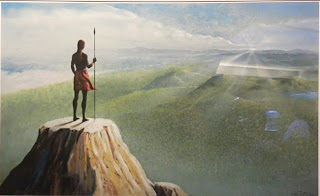
Al Doggett Samburu Land -looking over his lost land. The guard in the exhibition told me how much he loved this work because he was from East Africa and was eager to tell me about the Masai who live there.
Eddie Walker, James W. Washington Jr. Working

Yadisa Boija Recession an artist from Ethiopia. He says “We hear about the struggles of corporate financial institutions. We worry about the spending habits of consumers, charts, polls graphs. But who cares about ordinary people?”
 The title of this work is Invisibles and Boija’s label says that it “chronicles the life and struggles of immigrants new to their community and unaccepted in their homeland. They walk quietly unnoticed and unrecognized. “
The title of this work is Invisibles and Boija’s label says that it “chronicles the life and struggles of immigrants new to their community and unaccepted in their homeland. They walk quietly unnoticed and unrecognized. “
 The title of this work is Invisibles and Boija’s label says that it “chronicles the life and struggles of immigrants new to their community and unaccepted in their homeland. They walk quietly unnoticed and unrecognized. “
The title of this work is Invisibles and Boija’s label says that it “chronicles the life and struggles of immigrants new to their community and unaccepted in their homeland. They walk quietly unnoticed and unrecognized. “This entry was posted on February 20, 2010 and is filed under David Leonard, Eddie Walker, Esther Ervin, Fasika Moges, George Jennings, Seattle Municipal Building Ethnic Art Gallery, Sultan Mohammed, Yadisa Boija.
Sanctions, Divestment to End the Israeli Occupation
 That is eighty year old Judith Kolokoff next to me at what we called an informational demonstration at Trader Joe’s. We are nationwide and internationally joining people who are calling for divestment of Israeli investments and sanctions against Israeli products. Trader Joe’s carries cheese made on a farm that was land taken from Palestinians.
That is eighty year old Judith Kolokoff next to me at what we called an informational demonstration at Trader Joe’s. We are nationwide and internationally joining people who are calling for divestment of Israeli investments and sanctions against Israeli products. Trader Joe’s carries cheese made on a farm that was land taken from Palestinians.
It carries herbal pastes and coucous with a Trader Joe package that come from Israel. We are letting people know that they should not buy these products in support of the international boycott. Personally, I brought some of the cheese up to the service desk and complained and they said the company policy was to let people vote with their pocketbooks. So I have voted by not shopping at Trader Joe’s anymore ( that I realize is too extreme for most people, but their packaging is also terrible, and they carry endangered fish as well). The Israeli boycott campaign is not asking people to stop shopping at Trader Joe’s, only to stop buying products made in Israel.
Judith Kolokoff has a beautiful smile. She is a beautiful person. She told me that she has been demonstrating since she was ten years old in Chicago, when her parents were opposing Franco, Nazis, and fascism in Spain in the Spanish Civil War. She is a testimony to the fact that demonstrating is good for your health! I felt much better after this one hour of participating, than just sitting at home grumbling. If everyone got out for a cause just one hour a week, we would all be happier.
People say it doesn’t make any difference to demonstrate. But did you know that fire ants brought down the super conducting, supercollider in Texas. They were all on it and they destroyed it. We can do the same.
The new Obama budget includes 3 billion in military aid to Israel, but we can’t afford basic health care for people in the U.S. If you want to know how much your state is spending on military hardward for Israel, look at this website. In my state, Washington, up to 2018 we are giving 731,757,769.
This entry was posted on February 9, 2010 and is filed under Israeli sanctions, Trader Joe protest.





